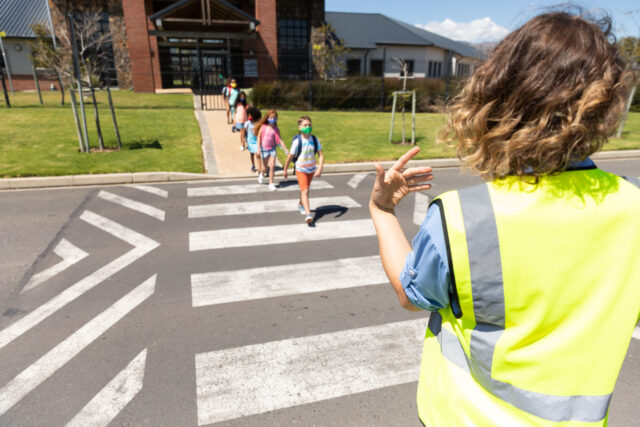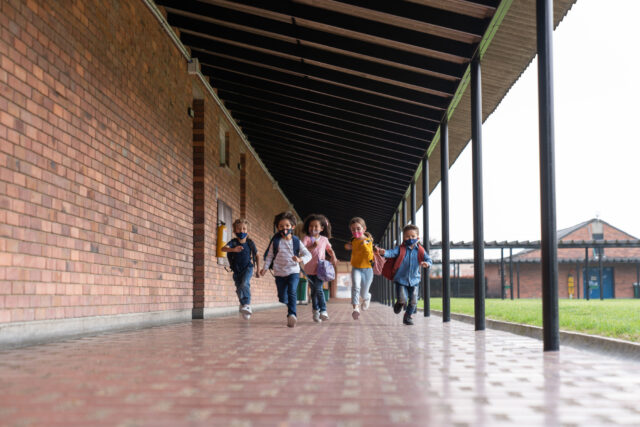One-time federal pandemic funds and increased state spending have contributed to record K–12 funding levels in recent years.
- In 2022–23, state, local, and federal funding for California K–12 public schools was roughly $127 billion, compared to roughly $133 billion in 2021–22 (estimates as of July 2023).
- The federal government allocated $34.2 billion in relief aid during the pandemic; federal funds accounted for 23% of K–12 funding in 2020–21 and 11% in 2021–22. In most non-recession years before the pandemic, the federal share ranged from 6% to 9%.
- In 2020–21 and 2021–22, the state distributed over $5 billion in federal COVID-19 recovery funding.
The state provides the majority of K–12 funding.
- Since 1990, the state share of K–12 funding has largely hovered between 54% and 61%; local shares have ranged from 32% to 36%.
- After reaching a 30-year low (51%) in 2020–21 with the influx of federal pandemic aid, the state share of funding has been above 62% for the past two years, slightly above historical levels.
- Between 2017–18 and 2022–23, state K–12 funding increased more than 40%.
California’s per pupil spending is slightly above the national average.
- In 2019–20 (the most recent school year for which we have nationally comparable data from the US Department of Education), spending per pupil on current operations (e.g., staff, materials) was $16,730 (in 2023$), roughly $700 more than the average in the rest of the nation ($16,023 per pupil).
- California spent less in 2019–20 than three of the five next most populous states: less than Illinois and Pennsylvania, and far less per pupil than the top-spending state, New York ($30,111). California spent more than Texas and Florida—both states spent roughly $12,300 per pupil.
- After ranking between 25th and 35th from the mid-1980s until after the Great Recession, California is now 19th in per pupil spending among states (including Washington, DC). When differences in labor costs across states are accounted for, California drops to 38th.
- California’s K–12 spending typically falls more than spending in other states during recessions—but it rises more quickly during economic recoveries.
California’s school funding formula allocates additional funding to higher-need students.
- The Local Control Funding Formula (LCFF), enacted in 2013–14, provides additional funding based on district shares of high-need students (low-income, English Learner, and/or foster youth); districts have spending flexibility but must submit Local Control and Accountability plans that describe goals, actions, and spending.
- LCFF generates a funding target for each district; the state funds what is not covered by local revenue. About 15% of districts are “basic aid”: their local revenue exceeds the target, and they retain these extra local funds.
- Per pupil spending in 2021–22 was higher for low-income than higher-income students (by $1,952), for English Learners (ELs) than non-ELs (by $903), and for Black and Latino than white students (by $2,231 and $1,937, respectively).
Despite record funding levels, the K–12 system faces fiscal challenges.
- With declines in California’s K–12 enrollment projected to continue through the next decade, most districts and counties will face the fiscal challenges of downsizing.
- District funding is based on average daily attendance (not enrollment); this means that relatively low student attendance levels and high rates of chronic absenteeism—especially among low-income, Black, and Latino students—have fiscal implications.
- Because roughly 80% of current spending is for staffing (teachers, support staff, etc.), increases in personnel costs—such as health coverage and other benefits—can have an outsized fiscal impact. Notably, rising pension contributions absorbed about 25% of the spending increase from 2013–14 to 2019–20.
- Districts will need to decide which pandemic-era school resources and services to continue after federal stimulus funding expires (in fall 2024); this will be challenging for schools that are still grappling with academic and social-emotional fallout from the pandemic.
Topics
K–12 EducationLearn More

Blog Post · December 1, 2023
Commentary: On California Funding Formula’s 10th Anniversary, Celebrate Progress but Double Down on Fairness

Report · September 2023
Examining the Reach of Targeted School Funding

Report · June 2023
District Spending of One-Time Funds for Educational Recovery

Report · May 2022
Understanding the Effects of School Funding

Report · March 2022
Equitable State Funding for School Facilities

Report · October 2021
Targeted K–12 Funding and Student Outcomes


